Catalogue > List by artist
Browse the entire list of Rencontre Internationales artists since 2004. Use the alphabetical filter to refine your search. update in progress
Guido Van Der Werve
Catalogue : 2006Nummer drie (take step fall) | Experimental film | 16mm | color | 10:38 | Netherlands | 2004
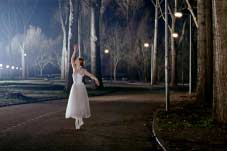
Guido Van Der Werve
Nummer drie (take step fall)
Experimental film | 16mm | color | 10:38 | Netherlands | 2004
Take step fall, a true story in which everthing and everyone gives up hope.
Guido van der Werve, born 7th. of april 1977 in Papendrecht, studied audiovisual arts at the Gerrit Rietveld Academie in Amsterdam, where he graduated in 2003. Before that he studied piano for a short period at the Rotterdam Conservatory. Starting out registrating performances on video, he changed later to working with film, a crew, his own piano playing and cinematographic elements. In this later work he makes short abstract stories based on elements that fits his state of mind. Guido van der Werve works is shown both in the art- and the filmcontext. With his graduation film; ?Nummer twee?, he won the René Coelho award from the Netherlands Institute for media art. His later film; Nummer drie got nominated for the NPS short film prize, and recently his oeuvre got nominated for the prestigues dutch state art award;? The prix de Rome?.
Guido Van Der Werve
Catalogue : 2008Nummer zes | Experimental video | dv | color | 17:9 | Netherlands | 2006
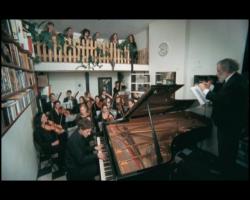
Guido Van Der Werve
Nummer zes
Experimental video | dv | color | 17:9 | Netherlands | 2006
A text against a somewhat grubby black background explains how the maker, ever since he was six years old, was in the habit of furnishing his room in only black and white; how one day a ray of sun reached his wall via a reflection from the façade of a glass building on the other side of the street, and how at night when he cannot sleep he goes for a walk and can hardly see a star in the sky. The camera zooms out and the black field turns out to be part of the black-and-white chequered floor in the artist?s apartment. He is sitting on a stool at his upright piano, with his back to the keyboard, immersed in thought. The voice-over recounts the history of Steinway & Sons? grand piano, and how very few pianists are privileged enough always to be able to play on such an instrument. The quay on which the apartment without grand piano is situated comes into view, and we can see Van der Werve continuing his musing, in the window of a pub, near a bridge, in a Chinese snack bar, while the Steinway seems to get further and further out of reach. Finally, we see him gazing through the window of a famous piano retailer that for many years stood in the heart of Amsterdam. Once inside, a brief conversation takes place with an eager shop assistant about the chosen concert grand piano, its price and ?possibilities?. As viewer, your heart sinks into your shoes. But then, the dream seems to have become true: the music swells, we can see the insides of a shiny black grand piano and Van der Werve?s hands playing the virginal white keys as if he has effortlessly been able to transport himself into the history just recounted. An entire chamber orchestra, conductor and all, fills the black-and-white room to accompany him in the playing of Chopin?s first piano concerto.
Guido Van Der Werve was born in 1977 in Papendrecht, a Rotterdam suburb. He studied archeology and Russian at university and then joined the Rotterdam Conservatoire to study piano and the Gerrit Rietveld Academy in Amsterdam. He is a residing artist at the Rijksakademie in Amsterdam. Eversince his first works, he has been interested in filmic support and cinematographic language and mixes narrative sequences with performances. The keys to his works always are the performance, the music and atmospherique scenes. He works using long shots and never solicits professional actors.
Catalogue : 2007Nummer vier | Experimental fiction | 16mm | color | 11:48 | Netherlands | 2005
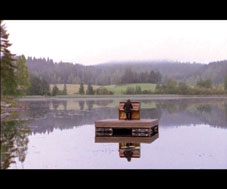
Guido Van Der Werve
Nummer vier
Experimental fiction | 16mm | color | 11:48 | Netherlands | 2005
Some things are as inevitable as gravity, however much we would like to avoid them: something with which the subtitle of this short film whole-heartedly agrees. In "Nummer vier", Guido van der Werve presents a contemporary form of spleen: nineteenth-century melancholy, mixed with Dutch sobriety and conceptual timing. Over and over again, we see an unlikely scene unfolding against a picturesque and serene background. A man playing a piano on a raft in the middle of a smooth lake; a choir and orchestra performing a requiem on a ship under sail; someone falling from the sky. Nothing world-shattering, but these are the ingredients with which "Nummer vier" introduces the important issues: nature, art, beauty, life, death. Subjects that no one can avoid, neither as a human being nor as an artist, but that can be defied ? just as gravity.
Guido van der Werve is an Amsterdam based artist, born on the 7th of April 1977 in Papendrecht, a suburb near Rotterdam, The Netherlands. Guido van der Werve studied art at the Gerrit Rietveld Academie and the Rijksakademie van Beeldende Kunsten in Amsterdam. Besides this he studied classical piano, Russian language and culture and Classical Archaeology. He is also working as a lecturer and teacher. His work consists of performance based films. Van der Werve's work has been shown numerously in both the major art and film venues. He received the René Coelho Award (of the Netherlands Media Art Institute, Montevideo/TBA) in 2003. He was nominated in 2004 for the NPS short film award, and in 2005 for the Prix de Rome in The Netherlands. Currently he is being represented by Gallery Olaf Stueber in Berlin, Gallery Monitor in Rome and Gallery Juliette Jongma in Amsterdam.
Guido Van Der Werve
Catalogue : 2007Nummer Vier | Experimental fiction | 35mm | color | 11:45 | Netherlands | 2005
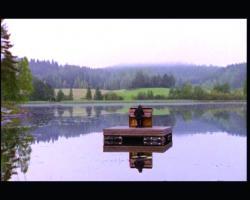
Guido Van Der Werve
Nummer Vier
Experimental fiction | 35mm | color | 11:45 | Netherlands | 2005
Some things are as inevitable as gravity, no matter how much we would like to avoid them: something with which the subtitle of this short film whole-heartedly agrees. In "Nummer Vier", Guido van der Werve presents a contemporary form of spleen: nineteenth-century melancholy, mixed with Dutch sobriety and conceptual timing. Over and over again, we see an unlikely scene unfolding against a picturesque, serene background. A man playing a piano on a raft in the middle of a smooth lake; a choir and orchestra performing a requiem on a ship under sail; someone falling from the sky. Nothing world-shattering, but these are the ingredients with which "Nummer vier" introduces the important issues: nature, art, beauty, life, death; subjects that no-one can avoid, neither as a human being nor as an artist, but that can be defied ? just as gravity.
Bart Van Dijck
Catalogue : 2008The Foil | Documentary | dv | color | 6:0 | Belgium, Russia | 2007

Bart Van Dijck
The Foil
Documentary | dv | color | 6:0 | Belgium, Russia | 2007
When I was in the south of Tuva, close to the Mongolian border a shaman told me I should search for a shamanic tree back home and do a ritual there. This tree should give me strength, good health and power.
There is a mutual interaction between the sculptures and installations of Bart Van Dijck on the one hand and is videos and documentaries on the other hand. As well the content as the form of his work has been influenced by his many travels, mostly through Asian and Arab countries. Topics such as culture shock, globalisation, alienation and cultural identity are recurring themes throughout his oeuvre. Detachment from reality, inner travels, trance and shamanism are a source of inspiration. Animal and human forms seem to take part in one large ritual. Alienation and plasticity are the key words in the particularly personal and eclectic universe of Van Dijck. www.axe-entertainment.tk
Ludivine Van Gaver
Catalogue : 2007La ritournelle | Experimental video | dv | color | 8:40 | France | 2005
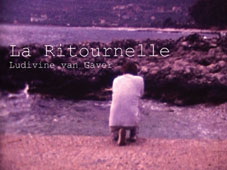
Ludivine Van Gaver
La ritournelle
Experimental video | dv | color | 8:40 | France | 2005
I ask myself: When do I hum? I say: I hum on three occasions. I hum when I move around my territory and clean my furniture. Meaning when I am home. I hum when I am not at home and trying to return home, when the night falls, the hour of anguish. I look for my way and give myself courage by singing tralala. I am going towards home. And then I hum as I say: Adieu, I am leaving and in my heart I will take heart...
Ludvine van Gaver studied montage at the Fémis after studying at the Ecole du Louvre and the Paris University 8 in Fine Arts. She is a film editor, a video director, and a photographer. She works and lives in Paris and Berlin.
Amanda Van Hesteren
Catalogue : 2023I Want to go Higher | Documentary | hdcam | color | 23:15 | Netherlands | 2022
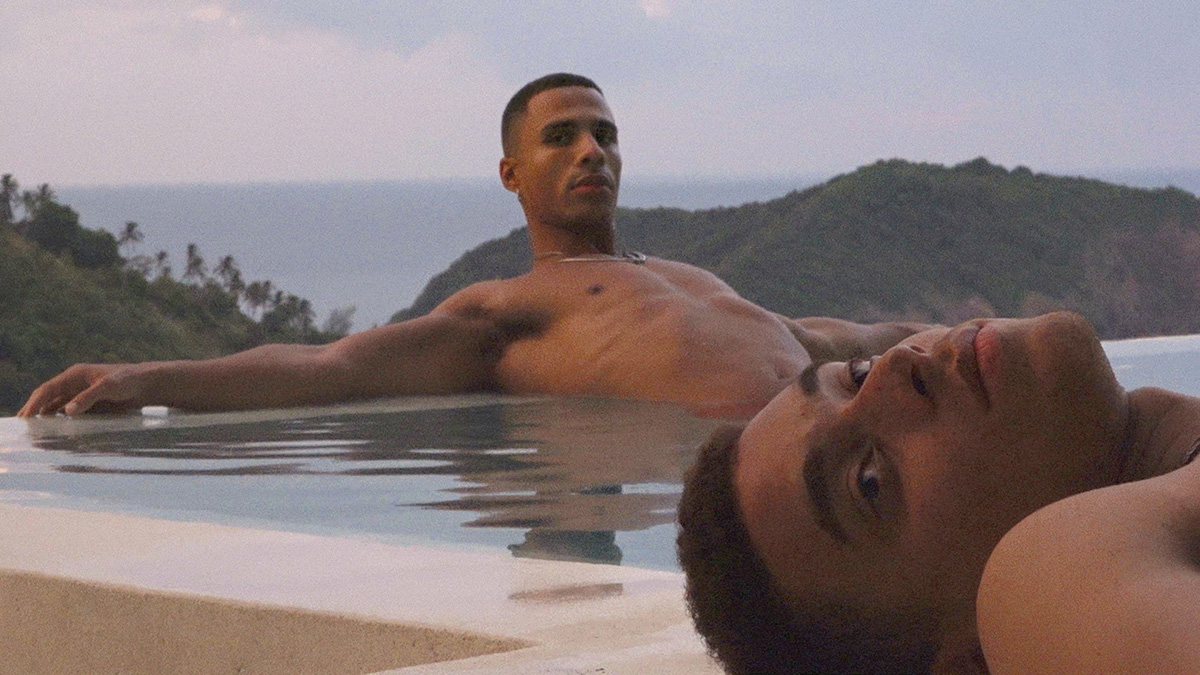
Amanda Van Hesteren
I Want to go Higher
Documentary | hdcam | color | 23:15 | Netherlands | 2022
In this sensitive portrait four male models make a sincere attempt to get to know themselves better during a retreat in Thailand. While the most sensitive boy, Arjan, actively talks about the patterns he wants to break and spends a lot of time in bed, the most dominant boy in the group, Jamal, likes to be the center of attention. Among themselves, the boys behave over the top; riding naked on a scooter, renting exaggerated villas and doing photo shoots for Instagram, while you keep feeling something chafe inside. In private conversations with filmmaker Amanda van Hesteren, we learn more about their individual insecurities as the boys' vulnerabilities unfold in different ways. When you change from boy to man: where do you leave your story and how do you explore with your friends what you can and cannot tell them?
Amanda van Hesteren (1991) graduated Cum Laude from her Audiovisual Arts program at LUCA School of Arts in Brussels with a semester at the School of Visual Arts in New York in 2019. Her first two short films were about her vacation lovers in Thailand and Jamaica and have been regularly screened at various art festivals in the Netherlands and Belgium. Her graduation film Mommy and me: yes but no/no but yes (2019) was co-produced by Dutch Broadcaster VPRO. In 2019 she had a solo exhibition at gallery ALMA SARIF in Brussels, and is currently preparing her second, which will take place at the Kunstverein in Cologne in March 2024. In 2021 she participated the IDFA Project Space where she developed a new script for her first feature documentary which she is currently making with production company Halal and Dutch public broadcaster VPRO as well as a documentary serie. Amanda's style is edgy, intimate and transparent. With her disarming gaze, she creates honest films in which she and her protagonists learn new things about the psyche of humanity and themselves.
Bas Van Koolwijk
Catalogue : 2007FBCK/AV Red Flag | Experimental video | dv | color | 6:8 | Netherlands | 2005
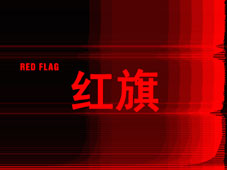
Bas Van Koolwijk
FBCK/AV Red Flag
Experimental video | dv | color | 6:8 | Netherlands | 2005
"FBCK/AV - Red Flag" provokes the observer with a penetrating sound and a flickering red image that refuses to take on a recognizable form. In order to generate this image, Bas van Koolwijk developed software which, again and again, transforms the input of audio and video signals into unique abstractions. Small doses of these signals can poach on each other's preserves, so that the computer converts sound information into image and image into sound ? a matter of data feedback. The resulting interference looks a bit like flagging, a term and phenomenon from the times of video tapes. Flagging occurs when a video tape does not run smoothly through the recorder, and the phenomenon is usually visible in the upper part of the image. With this reference to the analogue era, the viewer's thoughts are taken even further 'back', towards the capricious and chaotic nature of flags fluttering in the wind. But is also refers to the Babel-like confusion that governs this digital era due to the fact that (with all the codecs and formats) much of the software available only provides for limited readability and exchangeability of data.
Bas Van Koolwijk
Catalogue : 2007FBCK/AV - Red flag | Experimental video | dv | color | 2:59 | Netherlands | 2005
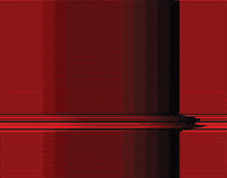
Bas Van Koolwijk
FBCK/AV - Red flag
Experimental video | dv | color | 2:59 | Netherlands | 2005
"FBCK/AV - Red Flag" provokes the observer with a penetrating sound and a flickering red image that refuses to take on a recognizable form. In order to generate this image, Bas van Koolwijk developed software which, again and again, transforms the input of audio and video signals into unique abstractions. Small doses of these signals can poach on each other's preserves, so that the computer converts sound information into image and image into sound ? a matter of data feedback. The resulting interference looks a bit like flagging, a term and phenomenon from the times of video tapes. Flagging occurs when a video tape does not run smoothly through the recorder, and the phenomenon is usually visible in the upper part of the image. With this reference to the analogue era, the viewer's thoughts are taken even further 'back', towards the capricious and chaotic nature of flags fluttering in the wind. But is also refers to the Babel-like confusion that governs this digital era due to the fact that (with all the codecs and formats) much of the software available only provides for limited readability and exchangeability of data.
Jan Van Nuenen
Catalogue : 2006Warning, petroleum pipeline | Experimental video | dv | color | 4:50 | Netherlands | 2004
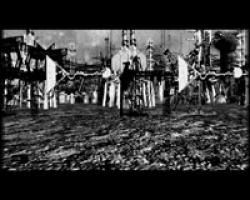
Jan Van Nuenen
Warning, petroleum pipeline
Experimental video | dv | color | 4:50 | Netherlands | 2004
"A desolate and deserted landscape slowly turns into a futuristic industrialized world. Indescribable machines are connected up to more complex mechanisms which rhythmically produce industrial music."
"After studying audio-visual design at St. Joost Art Academy in Breda, Netherlands, from 1997 to 2002, Jan Van Nuenen mainly worked on short experimental animation films and video installations until 2005. His favourite tools are digital editing software such as After Effects, Photoshop, Premiere, Reactor and FL Studio. His films are mostly made from collages of video footage he finds and pictures he cuts, mixes and edits with the computer. His work is characterized by a combined and complex action of loops, repetitions and rhythms, in which sound plays a major role. Jan Van Nuenen also made short animations movies for the series of the Dutch channel VPRO, "Wonderland" (2004), and his films are shown in several international film, video and art festivals."
Jan Van Nuenen
Catalogue : 2008Evolizer | Experimental video | dv | color | 15:0 | Netherlands, Germany | 2007

Jan Van Nuenen
Evolizer
Experimental video | dv | color | 15:0 | Netherlands, Germany | 2007
Evolizer NL, 2007, 10`37? In a space that looks like a town or a factory, but could just as well be the inside of a computer, a robot-like figure is moving along. The camera zooms in on a kind of small cabinet that seems to suck the viewer in. Some elements are being added to this technological, geometric environment, which bring about rearrangements and transformations here and there. Spontaneous modulations create a proliferation of colourful, organic forms. With their tentacles grasping around them, these organisms gradually and increasingly take possession of the space. An aquarium-like underworld, in which an aggressive struggle for life is taking place, then replaces the orderly universe where the viewer?s trip began. This (r)evolution, unfolding within a well-defined space, breaks out of the cabinet before the eyes of the little figure, and continues outside it.
Catalogue : 2007Warning Petroleum Pipeline | Animation | dv | black and white | 4:45 | Netherlands | 2004
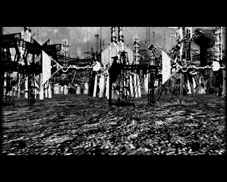
Jan Van Nuenen
Warning Petroleum Pipeline
Animation | dv | black and white | 4:45 | Netherlands | 2004
The movement of information across the worldwide web is invisible. Bits and bytes slip soundlessly through slender cables, to arrive, in no more than a split second, at the computer for which they are meant, where they can be used again at the click of a mouse. In contrast, the movement of oil is a messy and ponderous affair, which makes huge claims on the landscape and built-up areas. Bulky, rusty pipes traverse the fields, while trucks and tankers toil slowly over roads and oceans, accompanied by the threat of pollution and explosion. Both processes have drastically changed the world, and continue to keep economic and political relations on the alert. With its black-and-white collage-like images, "Warning Petroleum Pipeline" is reminiscent of art that, in the early twentieth century, was intended to depict the destructive power of the heavy emerging industry. Mysterious machines turn and hammer to a strict rhythm, and seem to be propagating themselves, creating a forest of moving components, sharp-edged plates and heavy cables. The fluent digital animation is a dark vision that not only shows destruction, but also, paradoxically, the uncontrollable creative power by which an industry can bring itself to fruition.
Wendelien Van Oldenborgh
Catalogue : 2022Hier. | Experimental doc. | 4k | color | 27:34 | Netherlands | 2021
Wendelien Van Oldenborgh
Hier.
Experimental doc. | 4k | color | 27:34 | Netherlands | 2021
Hier.(2021) moves seamlessly between politically charged reflections and personal memories through a constellation of voices and lyrical material. In Museum Arnhem (NL) during its renovation - a place of conservation in transition - we meet a cast of young women who express themselves through music, poetry and dialogue. Together they sensitively explore themes such as hybridity, trans-nationality and diasporic sensitivities in the midst of persistent reverberations of colonial history in contemporary society. Alongside the cast, the location Museum Arnhem, is also a meaningful “voice”. Originally built in the late 19th century as an ‘outdoors club’ by people with a colonial past, we see the building stripped down to its foundation, with worn concrete and elegant art nouveau features located next to each other. In this site of rubble and potential we follow three ‘sonic lines’: the band FRED, poet Pelumi Adejumo and historian Lara Nuberg. With music and poetry, we encounter not only socio-political urgencies, but also undercurrents of existentialist and vulnerable themes. Tenderly yet confident, we see the protagonists in friendship and cooperation, we hear about love, the sorrow that comes with it, life questions and certainties, by which they express the basis for a changing possible future.
Wendelien van Oldenborgh develops works, whereby the cinematic format is used as a methodology for production and as the basic language for various forms of presentation, collaborating with participants in different scenarios, to co-produce the script. Recent solo presentations include: work, work, work (work) at Museum Sztuki in Lodz 2021; tono lengua boca at Fabra i Coats, Barcelona 2020 and CA2M Madrid 2019-20; Cinema Olanda, at the Dutch Pavilion in the 57th Venice Biennial 2017. Van Oldenborgh has exhibited widely including the Chicago Architecture Biennial 2019, bauhaus imaginista, HKW Berlin 2019, Stedelijk Museum Amsterdam 2020 and Sonsbeek20->24, Arnhem 2021.
Catalogue : 2021Two Stones | Experimental doc. | hdv | color | 61:15 | Netherlands, Germany | 2020
Wendelien Van Oldenborgh
Two Stones
Experimental doc. | hdv | color | 61:15 | Netherlands, Germany | 2020
Two Stones explores the trajectories and ideals of the Bauhaus-trained, German architect Lotte Stam-Beese and the Caribbean activist and writer Hermina Huiswoud through dialogues and appearances by contemporary protagonists. Both Stam-Beese and Huiswoud spent time working in the Soviet Union in the early 1930s and both ended up being active in the Netherlands after WWII. Two Stones was filmed in the 1930s constructivist district of KhTZ in Kharkiv, Ukraine, the first large housing project on which Lotte Stam-Beese worked, and in Stam-Beese’s celebrated 1950s Pendrecht, designed during her period as Rotterdam’s main architect/urban planner. In the 1970s, Hermina Huiswoud was agitating against the Rotterdam housing rule, which limited Caribbean Dutch inhabitants to settle in any of the city’s districts if their presence would exceed 5% of the population. Resonances as well as dissonances between the distinct trajectories of the two women and their expectation from communist ideology, are sensed through thoughts and experiences of the protagonists, who all have a personal or professional relation to the issues at hand. Two Stones (2020), is a single image edit with two soundtracks played sequentially.
Wendelien van Oldenborgh develops works, whereby the cinematic format is used as a methodology for production and as the basic language for various forms of presentation, collaborating with participants in different scenarios, to co-produce the script. With these works, which look at the structures that form and hinder us, she participated in various large biennials, and in smaller dedicated shows. Recent solo presentations include: tono lengua boca at CA2M Madrid 2019-20 and Fabra i Coats Barcelona 2020; Cinema Olanda, at the Dutch Pavilion in the 57th Venice Biennial 2017. Van Oldenborgh has exhibited widely including at Kunsthall Wien 2020, Stedelijk Museum amsterdam 2020, the Chicago Architecture Biennial 2019, bauhaus imaginista, HKW Berlin, Zentrum Paul Klee Bern 2019 and SALT Istanbul 2020. Van Oldenborgh is a member of the (Dutch) Society for Arts and a recipient of the Dr. A.H. Heineken Prize for Art (2014). A monographic publication, Amateur, was published by Sternberg Press, Berlin; If I Can’t Dance, Amsterdam and The Showroom, London in 2016.
Catalogue : 2011Instruction | Experimental doc. | dv | color | 30:0 | Netherlands | 2009
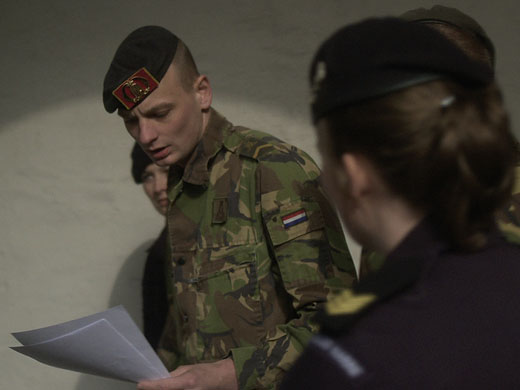
Wendelien Van Oldenborgh
Instruction
Experimental doc. | dv | color | 30:0 | Netherlands | 2009
The work of Wendelien van Oldenborgh often questions the position of the individual in a larger political framework and in a punitive social environment, challenging notions of personal and collective responsibility. Her film Instruction (2009) begins with William Faulkner`s famous quote from his book Requiem for a Nun: `The past is never dead. It`s not even past`. It addresses the unresolved traumatic events of the Dutch military intervention in Indonesia following World War II, euphemistically called a `police action`. The film casts a group of young cadets from the Royal Netherlands Military Academy who perform a script consisting of excerpts and quotes from different sources: personal diaries, historical broadcast transcripts related to the topic and essays, that all in a more or less direct way tackle collective responsibility and the heritage of the colonial past. The installation includes two photographs taken by the artist`s father during a trip to Indonesia in 1981. This was the first visit to the country by the artist`s mother since she spent four years in an Indonesian concentration camp after wwii. Instruction is located in the space between real people and the imaginary protagonists they represent; the artist leaves in a moment of dislocation in which young cadets stop to obediently follow the instructions of the script whilst spontaneous reactions of laughter or awkwardness are activated by their reading of the dialogue.
Lives and works in Rotterdam She studied at Goldsmiths College and Beaux Arts Paris, and now lives and works in Rotterdam, where she develops complex structures of collaborative work using the cinematic as methodology to focus on small actions and gestures in the public sphere that are taken as displayers of lager social conditions.
Wendelien Van Oldenborgh
Catalogue : 2023Obsada | Experimental doc. | 4k | color | 34:23 | Netherlands, Poland | 2021
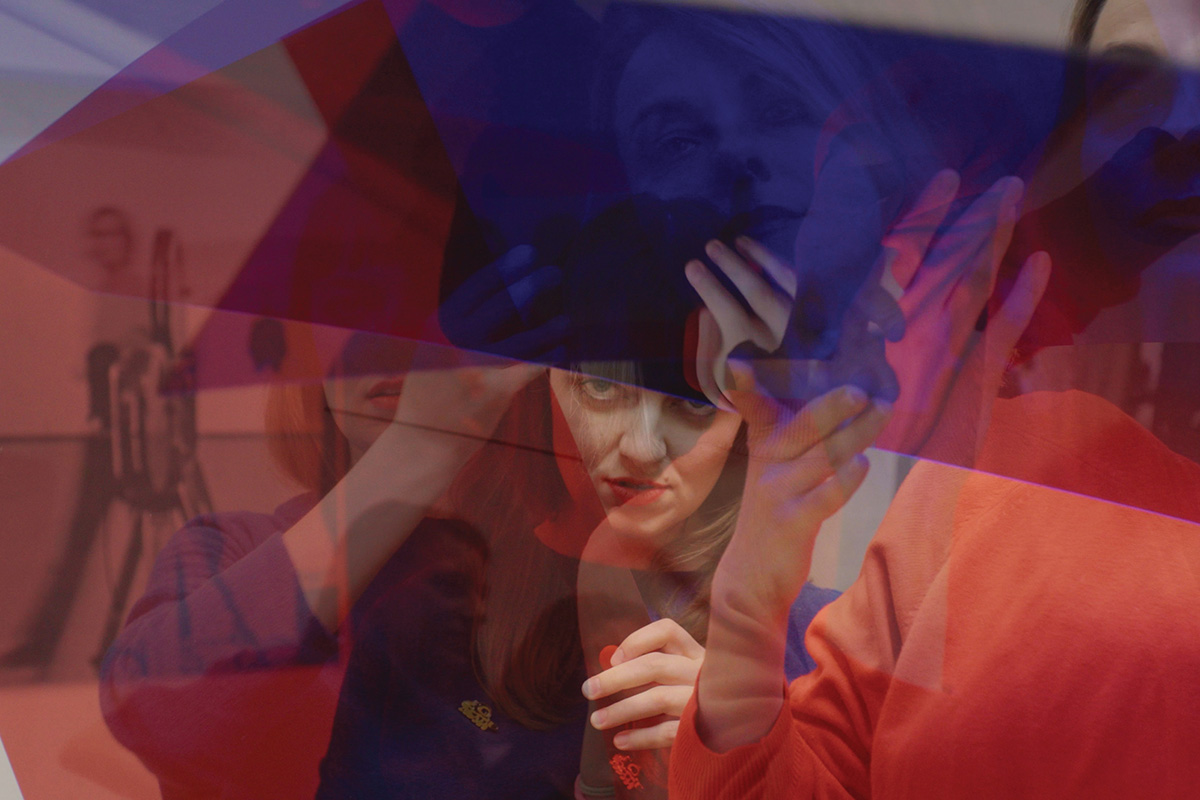
Wendelien Van Oldenborgh
Obsada
Experimental doc. | 4k | color | 34:23 | Netherlands, Poland | 2021
The Polish word “obsada" means "film cast” but can also mean "working party" - it connotes the distribution of work positions as well as placing of a plant in the ground. Wendelien van Oldenborgh’s obsada, is a collaboration with an all-female film crew, who are at the same time the film’s cast. It is an attempt to propose non-patriarchal narratives and methods of work. Involving a group of MA and PhD students from the Lodz Film School, the change they strive for does not consist simply in replacing men with women in film production; rather, the work develops in an open and improvised process – sensitive to the context of the place and the polyphony of the team. The women’s individual and collective experiences resonate with locations in the Film School and in Muzeum Sztuki in Lodz.
Wendelien van Oldenborgh develops works, whereby the cinematic format is used as a methodology for production and as the basic language for various forms of presentation, collaborating with participants in different scenarios, to co-produce the script. With these works, always shown in specially developed architectural settings, she shows widely in the art and museum context. Recent solo presentations include: unset on-set at Museum of Contemporary art Tokyo (MOT) 2022/23, tono lengua boca at CA2M Madrid 2019-20; Cinema Olanda, at the Dutch Pavilion in the 57th Venice Biennial 2017. Her work was recently included in Sonsbeek 20->24, Arnhem 2021; of bread, wine, cars, security and peace… at Kunsthalle Wien, 2020; Chicago Architecture Biennial 2019, Singapore Biennial 2019.
Wendelien Van Oldenborgh
Catalogue : 2025Of Girls | Experimental doc. | 4k | color | 43:13 | Netherlands, Japan | 2023
Wendelien Van Oldenborgh
Of Girls
Experimental doc. | 4k | color | 43:13 | Netherlands, Japan | 2023
Filmed in Tokyo and Yokohama, of girls brings a variety of contemporary voices in resonance with two distinct female voices from Japan’s literary and political past. Both popular authors of their time—the period from the late 1920s on—Fumiko Hayashi and Yuriko Miyamoto both died young, in 1951. They each had a strong feminist and class consciousness as well as an impressive literary voice, but came from very different backgrounds and expressed their ideals through different paths. The power and contradictions in both these women’s words reverberate in dialogues and images of an intergenerational cast moving through the various spaces of knowledge, memory and culture, and reflect today’s struggles around gender, politics, and love
Wendelien van Oldenborgh develops works, whereby the cinematic format is used as a methodology for production and as the basic language for various forms of presentation, collaborating with participants in different scenarios, to co-produce the script. With these works, always shown in specially developed architectural settings, she shows widely in the art and museum context. Recent solo presentations include: unset on-set at Museum of Contemporary art Tokyo (MOT) 2022/23, tono lengua boca at CA2M Madrid 2019-20; Cinema Olanda, at the Dutch Pavilion in the 57th Venice Biennial 2017. Her work was recently included in Delinking and Relinking, collection presentation van Abbemuseum 2021-2026; Sonsbeek 20->24,, Arnhem 2021; of bread, wine, cars, security and peace… at Kunsthalle Wien, 2020; Chicago Architecture Biennial 2019, Singapore Biennial 2019. Her films Two Stones (2019) , Hier. (2021) and of girls (2023) premiered in the International Competition of FID Marseille.
Petrus Van Staden, Malebogo, Tebogo
Catalogue : 2021Heaven Reaches Down to Earth | Fiction | 4k | color | 10:0 | South Africa | 2020
Petrus Van Staden, Malebogo, Tebogo
Heaven Reaches Down to Earth
Fiction | 4k | color | 10:0 | South Africa | 2020
After Tau comes to a realization about their sexuality, it sets in motion a cascade of thoughts and emotions in Tumelo - nothing will ever be the same between them.
Tebogo Malebogo and Petrus van Staden are a filmmaking duo originally from South Africa. They are driven to tell stories in various shapes that explore and discuss the beautifully complicated and diverse world that we live in.
Lea Van Steen, Raquel KOGAN
Catalogue : 2012Favela | Video | hdv | | 1:13 | Brazil | 2010
Lea Van Steen
Favela
Video | hdv | | 1:13 | Brazil | 2010
FAVELA [slum] superposes paths of seeing. Two sequences shots choreographed like coincident movements, shows the same itinerary but in different times. A city in a fast transformation, throwing away the past time. The images side by side in the screen, approaches the two moments at the same time that moves away the place to itself.
Lea van Steen researches new languages, using video, and video-installations as support. She spent many years collaborating with Brazilian cinema. When MTV Brazil was about to be launched, she got invited to take over as the new networks? Promo manager. She shaped MTV Brazil?s identity and then followed with many years working in advertising at many important production houses. As she matured her carrer as an adivertising director, she?s been more dedicated to her personal projects with short films, documentaries and art videos.
Catalogue : 2006bmg 8970 | Art vidéo | dv | color | 4:0 | Brazil | 2005
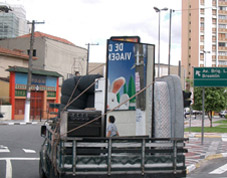
Lea Van Steen, Raquel KOGAN
bmg 8970
Art vidéo | dv | color | 4:0 | Brazil | 2005
An old move house truck, carrying different stuff, travel by the city. Between mattress, stove and sofas, a mirror, that reflects the images liven behind; bit of time, speed, contrasts from the urban space of a big metropolis, seen througt an unexpected cutting.
Lea Van Steen. After many years working with Art Direction on long feauture films, leads the team of MTV Promo(1990). Prized director of advertising and video-clips, wins a prize with the short feature film ?Brincadeira de criança? and the video-dance ?Paisagens?.
Raquel Kogan. Graduated in Architecture, the first individual exhibition was in 1996 at Monica Figueiras Gallery.Winning the Rumos Transmidia Itau Cultural in 2002, produces the Reflection installation, a large interactive waterfall of numbers upheld by a reflecting pool, also shown at Ciber@rt in Bilbao and Reflection#3 at the Festival @rtoutsiders 2005 in Paris. The investigation about interaction, agency of space, in digital media proceeds project, Projection in the Paço das Artes, interactive objects at Fotoarte in Brazilia and the intervention of Lord Palace Hotel in São Paulo, all in 2004. Begins 2005 exhibiting the work Self-Portrait 1, the installation Occupation #1, Reflection #2 at Kinetic_Digital.
Lea Van Steen
Catalogue : 2012Favela | Video | hdv | | 1:13 | Brazil | 2010
Lea Van Steen
Favela
Video | hdv | | 1:13 | Brazil | 2010
FAVELA [slum] superposes paths of seeing. Two sequences shots choreographed like coincident movements, shows the same itinerary but in different times. A city in a fast transformation, throwing away the past time. The images side by side in the screen, approaches the two moments at the same time that moves away the place to itself.
Lea van Steen researches new languages, using video, and video-installations as support. She spent many years collaborating with Brazilian cinema. When MTV Brazil was about to be launched, she got invited to take over as the new networks? Promo manager. She shaped MTV Brazil?s identity and then followed with many years working in advertising at many important production houses. As she matured her carrer as an adivertising director, she?s been more dedicated to her personal projects with short films, documentaries and art videos.
Catalogue : 2006bmg 8970 | Art vidéo | dv | color | 4:0 | Brazil | 2005

Lea Van Steen, Raquel KOGAN
bmg 8970
Art vidéo | dv | color | 4:0 | Brazil | 2005
An old move house truck, carrying different stuff, travel by the city. Between mattress, stove and sofas, a mirror, that reflects the images liven behind; bit of time, speed, contrasts from the urban space of a big metropolis, seen througt an unexpected cutting.
Lea Van Steen. After many years working with Art Direction on long feauture films, leads the team of MTV Promo(1990). Prized director of advertising and video-clips, wins a prize with the short feature film ?Brincadeira de criança? and the video-dance ?Paisagens?.
Raquel Kogan. Graduated in Architecture, the first individual exhibition was in 1996 at Monica Figueiras Gallery.Winning the Rumos Transmidia Itau Cultural in 2002, produces the Reflection installation, a large interactive waterfall of numbers upheld by a reflecting pool, also shown at Ciber@rt in Bilbao and Reflection#3 at the Festival @rtoutsiders 2005 in Paris. The investigation about interaction, agency of space, in digital media proceeds project, Projection in the Paço das Artes, interactive objects at Fotoarte in Brazilia and the intervention of Lord Palace Hotel in São Paulo, all in 2004. Begins 2005 exhibiting the work Self-Portrait 1, the installation Occupation #1, Reflection #2 at Kinetic_Digital.
Renée Van Trier
Catalogue : 2011Untitled, Los Angeles, 2009 | Video | dv | color | 3:21 | Netherlands, USA | 2009
Renée Van Trier
Untitled, Los Angeles, 2009
Video | dv | color | 3:21 | Netherlands, USA | 2009
Criticism of the beauty industry, wrapped in an awkward chat between two women. There needs to be much improved on the young body, because this can`t go longer. The creator / performer Renée van Trier not save herself.
Renée van Trier (1983, Netherlands) studied at the St.Joost in Breda and just graduated at the Sandberg Institute in Amsterdam. She works with different media like; video, photography, performance and music. In recognition of her work plays a role in changing identities and the conflict between the person and the adopted artificial identity. "An inner dalliance with the outside world that would otherwise flow," as she puts it. A game with a goal to look awake at the world around us.
Karl Van Welden
Catalogue : 2022Images For Mars II | Video | 4k | color | 28:37 | Belgium | 2019
Karl Van Welden
Images For Mars II
Video | 4k | color | 28:37 | Belgium | 2019
In the life-sized video work IMAGES FOR MARS II Karl Van Welden investigates the effect of a disaster on the human body. People in a state of carelessness until a dark ash rain falls upon them, turning their idyll into a catastrophe. Or how a blissful moment becomes a scene of charred bodies on a patch of scorched earth. The choreography and movements are inspired by archaeological finds from Pompeii and Herculaneum, which literally show the positions of bodies at the moment of a catastrophe. After the eruption of the Vesuvius volcano, its victims were enclosed by ashes. In time, the bodies disintegrated while the ash surrounding them solidified, creating cavities. Italian archaeologist Giuseppe Fiorelli filled these cavities with plaster, creating a very precise image of the victims of this natural disaster. They remind us of the marble figures on medieval tombs. Sleeping beauties and tormented bodies, which reflect the Eros and the Thanatos of our relationship with the end.
More than ten years ago Karl Van Welden initiated United Planets, a cycle of visual and performative work based on terrestrial or human presence in the universe. How does humankind relate to the immensity of the universe? Using the planets in our solar system as anchor points, he searches for artistic answers to this fundamental question. The work comprises performances as MARS, PLUTO, MERCURY or SATURN, but also video, installations, interventions, drawings, paintings and three-dimensional works, which can act as reflections, preliminary studies, but could just as easily exist autonomously or be combined into one work. Whether sound or image with these works the artist explores multilayeredness, balancing between autonomous poetics and subtle references to social or political themes. His work has been shown in a variety of contexts such as Kaaitheater, Beursschouwburg, Vooruit, M HKA, KANAL-Centre Pompidou, Festival of Flanders, Concertgebouw Bruges, Marion de Cannière, Frascati (NL), Brakke Grond (NL), Metropolis (DK), Pact Zollverein (DE), Østfold Kulturutvikling (NO), le CENTQUATRE-PARIS (FR), Marseille Provence 2013 (FR), Le Vivat (FR), Uzès Danse (FR), Arsenal (FR), Naves Matadero (ES), Tokyo Wonder Site - TOKAS (JP), Gessnerallee Zürich (CH), Sonica (UK), Venice Art Biennale (IT) and Art Basel Hong Kong (HK).
Sarah Vanagt
Catalogue : 2019Alle de tranen / Toute larme / Every Tear | Experimental doc. | hdv | color | 30:0 | Belgium | 2017
Sarah Vanagt
Alle de tranen / Toute larme / Every Tear
Experimental doc. | hdv | color | 30:0 | Belgium | 2017
In the 17th century, Antoni Van Leeuwenhoek, a draper from Delft, begins to make glass lenses, in order to better study the quality of his textile. He melts, drips and grinds small beads of glass. His tiny lenses are so bright and have such magnifying power that the draper seems to have entered a new dimension. Is he the first to see little moving “animals” in a drop of water? How to describe something that nobody ever saw before? In the film `Every Tear`, Sarah Vanagt starts a journey into her home city of Brussels, with Leeuwenhoek’s microscope in hand. She picks up bits and pieces on her road, and tries to find out what the first microscopic images may have looked like. She replaces the lens of her camera by the 17th-century lens. As she is filming, she wonders why we always look for shapes that we already know, whenever we are in the eye of the unknown.
Home News Work & Screenings Online Films About Contact Balthasar produces and presents the work of filmmaker Sarah Vanagt. Sarah Vanagt (1976) makes documentaries, video installations and photos, in which she combines her interest for history with her interest for (the origins of) cinema. Her work includes films such as After Years of Walking (2003), Little Figures (2003), Begin Began Begun (2005), Boulevard d`Ypres (2010), The Corridor (2010), Dust Breeding (2013); and video installations such as Les Mouchoirs de Kabila (2005), Power Cut (2007), Ash Tree (2007). Her work is shown at film festivals (FidMarseille, Viennale, Doclisboa, Idfa Amsterdam, Rencontres Internationales Paris/Madrid/Berlin, Hors Pistes Centre Pompidou), and in museums (Frankfurter Kunstverein, Fact Liverpool, NGBK Berlin, Shedhalle Zürich). The silent short film Girl with a fly (2013) was first shown at the 5th Biennale of Moscow. The films In Waking Hours (2015) and Still Holding Still (2015) premiered at the International Film Festival Rotterdam. The installation Showfish was presented in M HKA, the Museum for Contemporary Art of Antwerp in October 2016. Vanagt`s new film DIVINATIONS (2019) has it`s Belgian avant-premiere during the festival Courtisane in Ghent (3 April 2019)
Catalogue : 2013The Wave | Experimental doc. | hdv | color | 20:0 | Belgium, France | 2012
Sarah Vanagt, Vermeire Katrien
The Wave
Experimental doc. | hdv | color | 20:0 | Belgium, France | 2012
In "The Wave" the archaeological gaze of the viewer is set in motion: a mass grave from the Spanish Civil War (1936?39) opens and closes itself. In 2011 we placed a camera above the spot where nine victims were buried after their execution by Franco?s supporters in June 1939. On day one of the excavation, a digging crane gently loosened the top layer of soil, until the archaeologists came across a skull with a bullet hole. Then the archaeologists continued their work by hand. The skeletons appeared, then disappeared, as if a strong wind blew that removed the sand and uncovered death, a primal truth.
Sarah Vanagt studied history at the universities of Antwerp, Sussex and Groningen, and film at the National Film and Television School (UK). She makes documentaries, video installations and photos, in which she combines her interest for history with her interest for (the origins of) cinema. Her graduation film AFTER YEARS OF WALKING (2003) looks at the rewriting of Rwandan history after the genocide of 1994. In LITTLE FIGURES (2003), a short experimental documentary film, three immigrant children in Brussels play the role of three historical statues. The documentary film BEGIN BEGAN BEGUN (2005) and the video-installation LES MOUCHOIRS DE KABILA (2005) both focus on the play-world of children growing up in the war-torn border zone between Rwanda and the Democratic Republic of Congo, and look at the way in which children deal with death, the recent wars and elections. The short film FIRST ELECTIONS (2006) is a single-screen version of LES MOUCHOIRS DE KABILA. In 2007 Vanagt first presented POWER CUT at the Kunstenfestivaldesarts in Brussels. The installation consists of short videos and photos made by three Congolese street children, and of voice-recordings by two young soldiers who took part in the recent wars in Congo and Rwanda. The single-channel version of this installation is called SILENT ELECTIONS (2009). In HEAD (2007), the installation Vanagt made for the Young Belgian Painters Award, she combined super 8 footage of the ancient city of Pompei with images of new-born babies. The video installation ASH TREE (2007) is based on Mary Shelly`s childhood. A 5-year old girl wanders on a graveyard in London while she spells the letters on the graves. The child`s first contact with the alphabet is at once her first contact with death. Since 2006 Vanagt works on a series of photos of special graveyards and monuments in Europe. The photo series SOLAR CEMETERY (2009), about solar panels on a Spanish cemetery, was made with a camera obscura, and presented on solar-powered light boxes. BOULEVARD D`YPRES / IEPERLAAN (2010) is an experimental documentary shot in the street where Vanagt lives. She turned an empty store houses into a film studio, and invited her neighbours ? a mix of refugees, shopkeepers, newcomers ? to come and tell a story, a fairy tale. The short piece THE CORRIDOR (2010) focuses on the mute encounter between a donkey and an old man in an English nursing home. In October 2011 Katrien Vermeire en Vanagt filmed the exhumation of a mass grave of Franco victims in Spain. Based on the material they brought home from Spain they made a film (20`), a photo series and two wrapped flipbooks (title The Wave, 2012). Currently Vanagt is working on a film based on pencil rubbings made in the International Criminal Tribunal for the Former Yugoslavia in The Hague (premiere in May 2013).
Sarah Vanagt
Catalogue : 2016In Waking Hours | Experimental doc. | hdv | color | 18:13 | Belgium | 2015
Sarah Vanagt, Katrien Vanagt
In Waking Hours
Experimental doc. | hdv | color | 18:13 | Belgium | 2015
With the publication of the Ophthalmographia in 1632, the Amsterdam physician Vopiscus Fortunatus Plempius sheds new light on the age-old question of how seeing works. His answer is an invitation to experiment: Enter with me into a darkened room and prepare the eye of a freshly slaughtered cow. He emphasizes that anyone may carry out this experiment, at home, "demanding little effort and expense." “And you, standing in the darkened room, behind the eye, shall see a painting that perfectly represents all objects from the outside world,” promises Plempius. In the short film In Waking Hours we see historian Katrien Vanagt - who studied the Latin writings of this Plempius - cloaked in the skin of a 21st-century disciple of Plempius. Her cousin, filmmaker Sarah Vanagt, is there and captures how this modern "Plempia" meticulously follows her teacher`s instructions. Thus, in a dark kitchen in Brussels, they become witnesses at the birth of images upon the eye.
Sarah Vanagt (1976) makes documentaries, video installations and photos, in which she combines her interest for history with her interest for (the origins of) cinema. Her work includes films such as After Years of Walking (2003), Little Figures (2003), Begin Began Begun (2005), Boulevard d`Ypres (2010), The Corridor (2010), Dust Breeding (2013); and video installations such as Les Mouchoirs de Kabila (2005), Power Cut (2007), Ash Tree (2007). Her work is shown at film festivals (FidMarseille, Viennale, Doclisboa, Idfa Amsterdam, Rencontres Internationales Paris/Madrid/Berlin, Hors Pistes Centre Pompidou), and in museums (Frankfurter Kunstverein, Fact Liverpool, NGBK Berlin, Shedhalle Zürich). The silent short film Girl with a fly (2013) was first shown at the 5th Biennale of Moscow. The film In Waking Hours (2015) premiered at the International Film Festival Rotterdam. Vanagt`s most recent film Still holding still (2015) was first shown at Idfa Amsterdam, after its Belgian première on 22 October 2015 (Beursschouwburg, Brussels).
Catalogue : 2007Little Figures | Experimental fiction | dv | color and b&w | 15:47 | Belgium | 2003
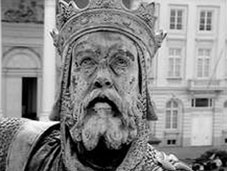
Sarah Vanagt
Little Figures
Experimental fiction | dv | color and b&w | 15:47 | Belgium | 2003
In "Little Figures" Sarah Vanagt once again plays around with her passion for history, perspective, and social commitment. Setting out from a location, the 'Kunstberg', but specifically the three statues located there, Vanagt puts together a story in which migrant children stir up a conversation between the statues, in an often surprising and witty tone, being (un)able to situate them historically. It is no coincidence that colonialism and the crusades pop up as references. The scene has a decelerated, halted aspect, which reinforces the feeling of recollection, and it makes headway for the arising associations.
Born in 1976, Sarah Vanagt studied History at the universities of Antwerp, Groningen, and Brighton. Apart from a passion for history, she has one for film as well. Sarah Vanagt looked for a combination and found it by carrying out historical research from the practice of film. In order to develop a cinematic language of her own she started training at the London National Film and Television School (documentary direction department). During that time she worked mainly with refugee children from Rwanda and their perception of and relation to the past. This resulted in the graduation project "After years of walking" (2003). Her work has been shown at IDFA in Amsterdam, Tate Modern in London, MNCARS in Madrid, and Transmediale in Berlin. She lives and works in Brussels.
Sarah Vanagt, Vermeire Katrien
Catalogue : 2019Alle de tranen / Toute larme / Every Tear | Experimental doc. | hdv | color | 30:0 | Belgium | 2017
Sarah Vanagt
Alle de tranen / Toute larme / Every Tear
Experimental doc. | hdv | color | 30:0 | Belgium | 2017
In the 17th century, Antoni Van Leeuwenhoek, a draper from Delft, begins to make glass lenses, in order to better study the quality of his textile. He melts, drips and grinds small beads of glass. His tiny lenses are so bright and have such magnifying power that the draper seems to have entered a new dimension. Is he the first to see little moving “animals” in a drop of water? How to describe something that nobody ever saw before? In the film `Every Tear`, Sarah Vanagt starts a journey into her home city of Brussels, with Leeuwenhoek’s microscope in hand. She picks up bits and pieces on her road, and tries to find out what the first microscopic images may have looked like. She replaces the lens of her camera by the 17th-century lens. As she is filming, she wonders why we always look for shapes that we already know, whenever we are in the eye of the unknown.
Home News Work & Screenings Online Films About Contact Balthasar produces and presents the work of filmmaker Sarah Vanagt. Sarah Vanagt (1976) makes documentaries, video installations and photos, in which she combines her interest for history with her interest for (the origins of) cinema. Her work includes films such as After Years of Walking (2003), Little Figures (2003), Begin Began Begun (2005), Boulevard d`Ypres (2010), The Corridor (2010), Dust Breeding (2013); and video installations such as Les Mouchoirs de Kabila (2005), Power Cut (2007), Ash Tree (2007). Her work is shown at film festivals (FidMarseille, Viennale, Doclisboa, Idfa Amsterdam, Rencontres Internationales Paris/Madrid/Berlin, Hors Pistes Centre Pompidou), and in museums (Frankfurter Kunstverein, Fact Liverpool, NGBK Berlin, Shedhalle Zürich). The silent short film Girl with a fly (2013) was first shown at the 5th Biennale of Moscow. The films In Waking Hours (2015) and Still Holding Still (2015) premiered at the International Film Festival Rotterdam. The installation Showfish was presented in M HKA, the Museum for Contemporary Art of Antwerp in October 2016. Vanagt`s new film DIVINATIONS (2019) has it`s Belgian avant-premiere during the festival Courtisane in Ghent (3 April 2019)
Catalogue : 2013The Wave | Experimental doc. | hdv | color | 20:0 | Belgium, France | 2012
Sarah Vanagt, Vermeire Katrien
The Wave
Experimental doc. | hdv | color | 20:0 | Belgium, France | 2012
In "The Wave" the archaeological gaze of the viewer is set in motion: a mass grave from the Spanish Civil War (1936?39) opens and closes itself. In 2011 we placed a camera above the spot where nine victims were buried after their execution by Franco?s supporters in June 1939. On day one of the excavation, a digging crane gently loosened the top layer of soil, until the archaeologists came across a skull with a bullet hole. Then the archaeologists continued their work by hand. The skeletons appeared, then disappeared, as if a strong wind blew that removed the sand and uncovered death, a primal truth.
Sarah Vanagt studied history at the universities of Antwerp, Sussex and Groningen, and film at the National Film and Television School (UK). She makes documentaries, video installations and photos, in which she combines her interest for history with her interest for (the origins of) cinema. Her graduation film AFTER YEARS OF WALKING (2003) looks at the rewriting of Rwandan history after the genocide of 1994. In LITTLE FIGURES (2003), a short experimental documentary film, three immigrant children in Brussels play the role of three historical statues. The documentary film BEGIN BEGAN BEGUN (2005) and the video-installation LES MOUCHOIRS DE KABILA (2005) both focus on the play-world of children growing up in the war-torn border zone between Rwanda and the Democratic Republic of Congo, and look at the way in which children deal with death, the recent wars and elections. The short film FIRST ELECTIONS (2006) is a single-screen version of LES MOUCHOIRS DE KABILA. In 2007 Vanagt first presented POWER CUT at the Kunstenfestivaldesarts in Brussels. The installation consists of short videos and photos made by three Congolese street children, and of voice-recordings by two young soldiers who took part in the recent wars in Congo and Rwanda. The single-channel version of this installation is called SILENT ELECTIONS (2009). In HEAD (2007), the installation Vanagt made for the Young Belgian Painters Award, she combined super 8 footage of the ancient city of Pompei with images of new-born babies. The video installation ASH TREE (2007) is based on Mary Shelly`s childhood. A 5-year old girl wanders on a graveyard in London while she spells the letters on the graves. The child`s first contact with the alphabet is at once her first contact with death. Since 2006 Vanagt works on a series of photos of special graveyards and monuments in Europe. The photo series SOLAR CEMETERY (2009), about solar panels on a Spanish cemetery, was made with a camera obscura, and presented on solar-powered light boxes. BOULEVARD D`YPRES / IEPERLAAN (2010) is an experimental documentary shot in the street where Vanagt lives. She turned an empty store houses into a film studio, and invited her neighbours ? a mix of refugees, shopkeepers, newcomers ? to come and tell a story, a fairy tale. The short piece THE CORRIDOR (2010) focuses on the mute encounter between a donkey and an old man in an English nursing home. In October 2011 Katrien Vermeire en Vanagt filmed the exhumation of a mass grave of Franco victims in Spain. Based on the material they brought home from Spain they made a film (20`), a photo series and two wrapped flipbooks (title The Wave, 2012). Currently Vanagt is working on a film based on pencil rubbings made in the International Criminal Tribunal for the Former Yugoslavia in The Hague (premiere in May 2013).